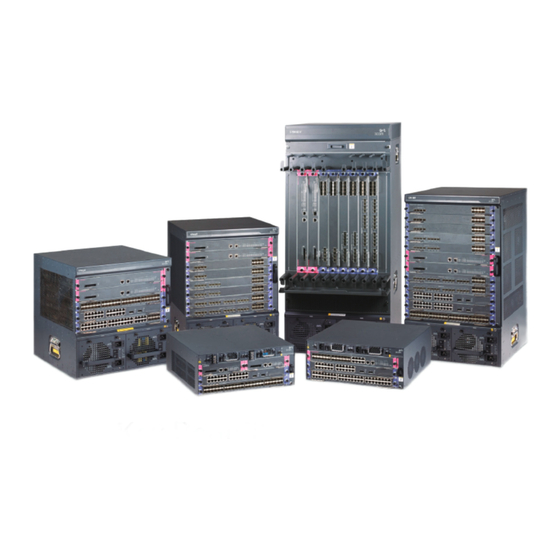
H3C S7500E-XS Faq
Hide thumbs
Also See for S7500E-XS:
- Installation manual (64 pages) ,
- Troubleshooting manual (61 pages) ,
- Command reference manual (42 pages)
Advertisement
Quick Links
H3C S7500E-XS Switch Series FAQ
Copyright © 2016 Hangzhou H3C Technologies Co., Ltd. All rights reserved.
No part of this manual may be reproduced or transmitted in any form or by any means
without prior written consent of Hangzhou H3C Technologies Co., Ltd.
The information in this document is subject to change without notice.
Advertisement

Subscribe to Our Youtube Channel
Summary of Contents for H3C S7500E-XS
- Page 1 H3C S7500E-XS Switch Series FAQ Copyright © 2016 Hangzhou H3C Technologies Co., Ltd. All rights reserved. No part of this manual may be reproduced or transmitted in any form or by any means without prior written consent of Hangzhou H3C Technologies Co., Ltd.
- Page 2 Q. What are the differences between the system operating modes? ............4 Q. What is the maximum number of equal-cost multi-path (ECMP) route groups supported by the S7500E-XS Switch Series? ....................... 4 Q. How many monitor ports does the switch support? ................4 Service functions ............................
- Page 3 Q. How many PEXs can be attached to the S7500E-XS parent fabric in an IRF 3 system and what virtual chassis numbers can the PEXs use? ................7 Q. What ports can I use as PEX physical interfaces on the S7500E-XS parent fabric in an IRF 3 system? ............................7 Q.
- Page 4 Q. What is the difference between EVI edge devices and PE devices? ..........10 Q. What are extended VLANs? ....................... 10 Q. Under what conditions should I configure selective flood for a MAC address? ........10 Q. How does EVI prevent forwarding loops? ..................10 Q.
- Page 5 For example, the wire speed of a fast Ethernet link is 100 Mbps. Q. What transceiver modules and cables are available for the SFP+ ports on the switch? A. For the transceiver modules and cables available for the SFP+ ports on the switch, see H3C S7500E-XS Switch Series Installation Guide.
- Page 6 Q. What is the operating temperature and upper and lower temperature thresholds of the switch? A. For S7500E-XS switches, the operating temperature must be in the range of 0°C (32°F) to 45°C (113°F). You can use the display environment command to display the switch temperature statistics, including the current temperature and temperature thresholds.
- Page 7 Q. How is the switch designed for high availability? A. The switch is designed as follows for high availability: • Power system—2+2 redundancy on an S7504E-XS switch and 1+1 redundancy on other S7500E-XS switches. Power modules and fan trays—Field replaceable.
-
Page 8: Service Functions
Q. What is the maximum number of equal-cost multi-path (ECMP) route groups supported by the S7500E-XS Switch Series? A. The S7500E-XS Switch Series supports a maximum of 4095 ECMP route groups. Use the following formula to calculate the actual number supported by the switch: (16 ×... - Page 9 Q. Can an H3C S7500E-XS switch form an IRF fabric with devices from other switch series? A. No. An H3C S7500E-XS switch can form an IRF fabric only with switches from the same series. Q. How many member devices can an H3C S7500E-XS IRF fabric have? A.
- Page 10 A. The IRF physical interfaces add an IRF header to each packet before they forward the packets to the neighbor IRF member. The IRF header uses part of the bandwidth. Q. What device models does the S7500E-XS switch support as PEXs in an IRF 3 system? A. The switch supports the following devices as PEXs: S5120-HI series: •...
- Page 11 Q. How many PEXs can be attached to the S7500E-XS parent fabric in an IRF 3 system and what virtual chassis numbers can the PEXs use? A. A maximum of 30 PEXs can be attached to the S7500E-XS parent fabric in an IRF 3 system. The virtual chassis number must be 100 to 129.
- Page 12 Q. Why does the number of learned dynamic MAC addresses on an IRF fabric exceed the maximum number of MAC address entries allowed? A. This issue occurs when dynamic MAC addresses are out of synchronization among IRF member devices. In the output from the display mac-address statistic command: The Dynamic Unicast Address (Learned) Count field displays the total number of dynamic MAC addresses •...
- Page 13 Q. What restrictions and guidelines should I follow when I configure TRILL? A. You must make sure that TRILL ports and non-TRILL ports do not form loops in the network. As a best practice, assign TRILL ports and non-TRILL ports to different VLANs if they might form loops. Q.
- Page 14 Q. What is the difference between EVI edge devices and PE devices? A. In an EVI network, edge devices are located at the boundaries of customer sites. In an MPLS VPN network, provider edge (PE) devices are located at the boundaries of the service provider network. Q.









Need help?
Do you have a question about the S7500E-XS and is the answer not in the manual?
Questions and answers